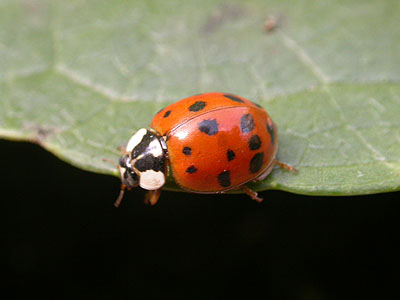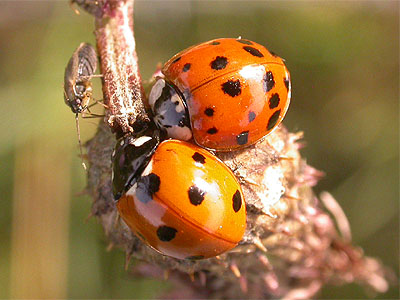 |
| The Harlequin Ladybird at Eakring - a new species for Nottinghamshire |
| .... |
 |
| The Harlequin Ladybird at Eakring - a new species for Nottinghamshire |
| .... |
| Nottinghamshire has a new species of ladybird. The Harlequin's recent arrival into the county, has brought with it fears that it could pose a real threat to many of our native species, with a more varied diet and voracious appetite. The Eakring and Kersall area provided the county with this expected ladybird and as 2006 progressed, further records have eventually followed including the discovery of over 151 adults at Hare Hill Wood in early November. | ||
| .... | ||
| UK history of the
Harlequin The Harlequin Ladybird (Harmonia axyridis) first appeared in the UK in 2004. Within the space of a couple of years, it has now reached the north-west of England and the Welsh borders. After it's arrival, the Harlequin has continued to colonise new areas of the country and substantially strengthened existing populations in the south-east. In parts of London it is already just about the commonest ladybird you'll see. With a Harlequin found in central Derby in October 2004, it was easy to suggest that it would be found in neighbouring Nottinghamshire in 2005. During 2005 Harlequin sightings came from near the Notts border at Stanley, as the Derbyshire population spread to outlying areas. But it seems as though the move into Nottinghamshire never happened, if a lack of submitted records or potential sightings is anything to go by. Nottinghamshire only had to wait until the end of July 2006 for it's long awaited first acceptable record. |
 |
|
| .... | ||
The Eakring record Although always on the lookout for them, we doubted that the adult Harlequin we found at Eakring Meadows on July 29th, would indeed be the first for the county. However, after a few days and several e-mails later, it was finally confirmed as the first acceptable record for Nottinghamshire. There had been a previous claim of a Harlequin Ladybird found in an Attenborough garden earlier in the year, but as there was no specimen or photograph as supporting evidence, the record could not be accepted by the county recorder Dr Sheila Wright. The morning of July 29th had been a very quiet one for birds. Eakring Flash had produced little of note, so I decided to try Penny Pasture Common for Redstart or Whinchat. It turned out to be equally as quiet there for birds and as there were a lot of hoverfly activity, I started to photograph the various species present on the Creeping Thistles. When I reached the north-western corner of Penny Pasture Common, I noticed two ladybirds of equal size, sat on a dead flowerhead. With a greater number of spots, I immediately recognised one as being a Harlequin Ladybird. The other was one of the many 7-spot Ladybirds which were present at the time and photographs were taken to show a direct comparison between the two species. |
||
| .... | ||
 |
I conducted a thorough
search of the rest of the Eakring Meadows area, but found
no more Harlequins. Further searches were done over the
following week, but all proved fruitless. The potential Harlequin threat The Harlequin Ladybird is of Asian origin and was introduced as a natural pest control into North America in 1988, where it is now the most widespread species. With a history of potential threat to American ladybirds, it was still introduced into Italy in the last decade, from where it has since spread throughout much of Europe, eventaully arriving in Britain during the Summer of 2004. It is predicted to spread rapidly throughout the UK and there are worries that it may outcompete other ladybird species and is regarded as a major threat to them and some other insect groups. |
| .... | ||
| Harlequin
distribution and spread within the UK during 2006 2006 has seen a huge north-westerly spread of range, as the Harlequin Ladybird continues it's extremely rapid colonisation of the UK. Both Wales and Cornwall have recorded their first Harlequin records and Scotland looks set to follow soon. There have been several more records from Nottinghamshire, although the Eakring record remains the first acceptable one on evidence. |
||
| .... | ||
Harlequin Ladybird distribution 10/08/06
© CEH Monks Wood 2006 |
Harlequin Ladybird distribution 16/11/06
© CEH Monks Wood 2006 |
|
| .... | ||
| Harlequin records at Eakring and Kersall | ||
| .... | ||
| Despite an almost continuous search of suitable habitat over the following weeks (including other parts of Nottinghamshire) and when a follow-up record began to look extremely unlikely, a second adult was found in the boot of the car during a moth trapping session at Lound Wood on October 19th. Lound Wood was thought at the time to have been the source of origin, but when 37 Harlequins were found at Hare Hill Wood on November 5th, it now seems likely that one was packed into the car accidentally after a moth trapping session there on October 18th. | ||
| .... |
| Further
information
Further information on this website can be found by clicking the links below. |